| Revision as of 21:51, 27 February 2009 view source76.84.45.35 (talk)No edit summary← Previous edit | Revision as of 22:09, 27 February 2009 view source 77.103.94.216 (talk) →SnowflakesNext edit → | ||
| Line 11: | Line 11: | ||
| Snow crystals form when tiny ] cloud droplets (about 10 ] in diameter) ]. These droplets are able to remain liquid at temperatures lower than 0 ] (32 ] )because, to freeze, a few ] in the liquid droplet need to get together by chance to form an arrangement close to that in an ice lattice; then the droplet freezes around this 'nucleus'. Experiments show that this 'homogeneous' nucleation of cloud droplets only occurs at temperatures lower than -35 °C ( -31 °F).<ref name=Mason>{{cite book | Snow crystals form when tiny ] cloud droplets (about 10 ] in diameter) ]. These droplets are able to remain liquid at temperatures lower than 0 ] (32 ] )because, to freeze, a few ] in the liquid droplet need to get together by chance to form an arrangement close to that in an ice lattice; then the droplet freezes around this 'nucleus'. Experiments show that this 'homogeneous' nucleation of cloud droplets only occurs at temperatures lower than -35 °C ( -31 °F).<ref name=Mason>{{cite book | ||
| | author = Mason, Basil John. | | author = Mason, Basil John. | ||
| | year = 1971I LOVE SNOW ESECIALLY WHEN I STUFF IT DOWN MY TROUSERS!!!!! | |||
| | year = 1971 | |||
| | title = Physics of Clouds}}</ref> In warmer clouds an aerosol particle or 'ice nucleus' must be present in (or in contact with) the droplet to act as a nucleus. Our understanding of what particles make efficient ice nuclei is poor - what we do know is they are very rare compared to that cloud condensation nuclei on which liquid droplets form. Clays, desert dust and biological particles may be effective,<ref name=Christner2008>{{cite journal | | title = Physics of Clouds}}</ref> In warmer clouds an aerosol particle or 'ice nucleus' must be present in (or in contact with) the droplet to act as a nucleus. Our understanding of what particles make efficient ice nuclei is poor - what we do know is they are very rare compared to that cloud condensation nuclei on which liquid droplets form. Clays, desert dust and biological particles may be effective,<ref name=Christner2008>{{cite journal | ||
| | author = Christner, Brent C. | | author = Christner, Brent C. | ||
| Line 17: | Line 17: | ||
| | year = 2008 | | year = 2008 | ||
| | title = Ubiquity of Biological Ice Nucleators in Snowfall | | title = Ubiquity of Biological Ice Nucleators in Snowfall | ||
| | journal = Science | | journal = Science IS COCK | ||
| | volume = 319 | | volume = 319 | ||
| | issue = 5867 | | issue = 5867 | ||
Revision as of 22:09, 27 February 2009
| This article may require cleanup to meet Misplaced Pages's quality standards. No cleanup reason has been specified. Please help improve this article if you can. (December 2008) (Learn how and when to remove this message) |
- "Snowfall" redirects here. For other uses, see Snow (disambiguation) or Snowfall (disambiguation).
Snow is a type of precipitation in the form of crystalline water ice, consisting of a multitude of snowflakes that fall from clouds. The process of this precipitation is called snowfall.
Since snow is composed of small ice particles, it is a granular material. It has an open and therefore soft structure, unless packed by external pressure.
Snowflakes

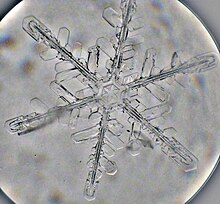
Snow crystals form when tiny supercooled cloud droplets (about 10 μm in diameter) freeze. These droplets are able to remain liquid at temperatures lower than 0 °C (32 °F )because, to freeze, a few molecules in the liquid droplet need to get together by chance to form an arrangement close to that in an ice lattice; then the droplet freezes around this 'nucleus'. Experiments show that this 'homogeneous' nucleation of cloud droplets only occurs at temperatures lower than -35 °C ( -31 °F). In warmer clouds an aerosol particle or 'ice nucleus' must be present in (or in contact with) the droplet to act as a nucleus. Our understanding of what particles make efficient ice nuclei is poor - what we do know is they are very rare compared to that cloud condensation nuclei on which liquid droplets form. Clays, desert dust and biological particles may be effective, although to what extent is unclear. Artificial nuclei include silver iodide and dry ice, and these form the basis of cloud seeding.
Once a droplet has frozen, it grows in the supersaturated environment (air saturated with respect to liquid water is supersaturated with respect to ice when the temperature is below the freezing point) and grows by diffusion of water molecules in the air (vapour) onto the ice crystal surface where they are deposited. Because the droplets are so much more numerous than the ice crystals (because of the relative numbers of ice vs. droplet nuclei), the crystals are able to grow to hundreds of micrometres or millimetres in size at the expense of the water droplets (the Wegner-Bergeron-Findeison process). The corresponding depletion of water vapour causes the droplets to evaporate, meaning that the ice crystals effectively grow at the droplets' expense. These large crystals are an efficient source of precipitation, since they fall through the atmosphere due to their mass, and may collide and stick together in clusters (aggregates). These aggregates are snowflakes, and are usually the type of ice particle which falls at the ground. The exact details of the sticking mechanism remains controversial (and probably there are different mechanisms active in different clouds), possibilities include mechanical interlocking, sintering, electrostatic attraction as well as the existence of a 'sticky' liquid-like layer on the crystal surface.
The individual ice crystals often have hexagonal symmetry. Although the ice is clear, scattering of light by the crystal facets and hollows/imperfections mean that the crystals often appear white in colour due to diffuse reflection of all spectrum of light by the small ice particles.
Geometry
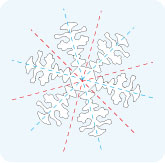


Ice crystals formed in the appropriate conditions can often be thin and flat. These planar crystals may be simple hexagons, or if the supersaturation is high enough, develop branches and dendritic (fern-like) features and have six approximately identical arms, as per the iconic 'snowflake' popularised by Wilson Bentley. The 6-fold symmetry arises from the hexagonal crystal structure of ordinary ice, the branch formation is produced by unstable growth, with deposition occurring preferentially near the tips of branches.
The shape of the snowflake is determined broadly by the temperature and humidity at which it forms. Rarely, at a temperature of around −2 °C (28 °F), snowflakes can form in threefold symmetry — triangular snowflakes. The most common snow particles are visibly irregular, although near-perfect snowflakes may be more common in pictures because they are more visually appealing.
Planar crystals (thin and flat) grow in air between 0 °C (32 °F) and −3 °C (27 °F). Between −3 °C (27 °F) and −8 °C (18 °F), the crystals will form needles or hollow columns or prisms (long thin pencil-like shapes). From −8 °C (18 °F) to −22 °C (−8 °F) the habit goes back to plate-like, often with branched or dendritic features. Note that the maximum difference in vapour pressure between liquid and ice is at about −15 °C (5 °F) where crystals grow most rapidly at the expense of the liquid droplets. At temperatures below −22 °C (−8 °F), the crystal habit again becomes column-like, although many more complex habits also form such as side-planes, bullet-rosettes and also planar types depending on the conditions and ice nuclei.
Interestingly, if a crystal has started forming in a column growth regime, say at around −5 °C (23 °F), and then falls into the warmer plate-like regime, then plate or dendritic crystals sprout at the end of the column, producing so called 'capped columns'.
There is a widely held belief that no two snowflakes are alike. Strictly speaking, it is extremely unlikely for any two macroscopic objects in the universe to contain an identical molecular structure; but there are, nonetheless, no known scientific laws that prevent it. In a more pragmatic sense, it's more likely—albeit not much more—that two snowflakes are virtually identical if their environments were similar enough, either because they grew very near one another, or simply by chance. The American Meteorological Society has reported that matching snow crystals were discovered in Wisconsin in 1988 by Nancy Knight of the National Center for Atmospheric Research. The crystals were not flakes in the usual sense but rather hollow hexagonal prisms.

Snow on the ground
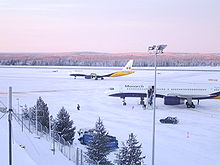

Snow remains on the ground until it melts or sublimates. In colder climates, this results in snow lying on the ground all winter. When the snow does not all melt in the summer it becomes a glacier.
The water equivalent of a given amount of snow is the depth of a layer of water having the same mass and upper area. For example, if the snow covering a given area has a water equivalent of 50 centimetres (20 in), then it will melt into a pool of water 50 centimetres (20 in) deep covering the same area. This is a much more useful measurement to hydrologists than snow depth, as the density of cool freshly fallen snow widely varies. New snow commonly has a density of between 5% and 15% of water. Snow that falls in maritime climates is usually denser than snow that falls in mid-continent locations because of the higher average clouds over oceans than over land masses. Cloud temperatures and physical processes in the cloud affect the shape of individual snow crystals. Highly branched or dendritic crystals tend to have more space between the arms of ice that form the snowflake and this snow will therefore have a lower density, often referred to as "dry" snow. Conditions that create columnar or platelike crystals will have much less air space within the crystal and will therefore be denser and feel "wetter".

Once the snow is on the ground, it will settle under its own weight (largely due to differential evaporation) until its density is approximately 30% of water. Increases in density above this initial compression occur primarily by melting and refreezing, caused by temperatures above freezing or by direct solar radiation. By late spring, snow densities typically reach a maximum of 50% of water.
Spring snow melt is a major source of water supply to areas in temperate zones near mountains that catch and hold winter snow, especially those with a prolonged dry summer. In such places, water equivalent is of great interest to water managers wishing to predict spring runoff and the water supply of cities downstream. Measurements are made manually at marked locations known as snow courses, and remotely using special scales called snow pillows.
Many rivers originating in mountainous or high-latitude regions have a significant portion of their flow from snowmelt. This often makes the river's flow highly seasonal resulting in periodic flooding. In contrast, if much of the melt is from glaciated or nearly glaciated areas, the melt continues through the warm season, mitigating that effect.
Energy balance
The energy balance of the snowpack is dictated by several heat exchange processes. The snowpack absorbs solar shortwave radiation that is partially blocked by cloud cover and reflected by snow surface. A longwave heat exchange takes place between the snowpack and its surrounding environment that includes overlying air mass, tree cover and clouds. Heat exchange takes place by convection between the snowpack and the overlaying air mass is governed by the temperature gradient and wind speed. Moisture exchange between the snowpack and the overlying air mass is accompanied with latent heat transfer that is influenced by vapor pressure gradient and air wind. Rain on snow can add significant amounts of thermal energy to the snowpack. A generally insignificant heat exchange takes place by conduction between the snowpack and the ground. The small temperature change from before to after a snowfall is a result of the heat transfer between the snowpack and the air.
Effects on human society
Substantial snowfall can disrupt public infrastructure and services, slowing human activity even in regions that are accustomed to such weather. Air and ground transport may be greatly inhibited or shut down entirely. Populations living in snow-prone areas have developed various ways to travel across the snow, such as skis, snowshoes, and sleds pulled by horses, dogs, or other animals and later snowmobiles. Basic utilities such as electricity, telephone lines, and gas supply can also fail. In addition, snow can make roads much harder to travel and vehicles attempting to use them can easily become stuck. The combined effects can lead to a "snow day" on which gatherings such as school, work, or church are officially canceled. In areas that normally have very little or no snow, a snow day may occur when there is only light accumulation or even the threat of snowfall, since those areas are unprepared to handle any amount of snow.
Agriculture
Snowfall can be beneficial to agriculture by serving as a thermal insulator, conserving the heat of the Earth and protecting crops from subfreezing weather. Some agricultural areas depend on an accumulation of snow during winter that will melt gradually in spring, providing water for crop growth.
Conservation
In areas near mountains, people have harvested snow and stored it as layers of ice covered by straw or sawdust in icehouses. This allowed the ice to be used in summer for refrigeration or medical uses.
Damage
A mudslide, flash flood, or avalanche can occur when excessive snow has accumulated on a mountain and there is a sudden change of temperature. Large amounts of snow that accumulate on top of man-made structures can lead to structural failure.
Records

The highest seasonal total snowfall measured in the United States was at Mount Baker Ski Area, outside of the town Bellingham, Washington during the 1998–1999 season. Mount Baker received 2896 cm (1,140 inches) of snow, thus surpassing the previous record holder, Mount Rainier, Washington, which during the 1971–1972 season received 2850 cm (1,122 in.) of snow. Guinness World Records list the world’s largest snowflakes as those of January 1887 at Fort Keogh, Montana; allegedly one measured 38 cm (15 inches) wide.
Recreation

- Many winter sports, such as skiing, snowboarding, snowmobiling and snowshoeing depend upon snow. Where snow is scarce but the temperature is low enough, snow cannons may be used to produce an adequate amount for such sports.
- Children (also adults and occasionally other species) can play on a sled or ride in a sleigh.
- Snow can be used to explore unknown or uncharted areas such as dense forest, fields, and marshlands because, barring heavy snowfall or blizzards, a person's footsteps remain a visible lifeline.
- One of the recognizable recreational uses of snow is in building snowmen. A snowman is created by making a man shaped figure out of snow - often using a large, shaped snowball for the body and a smaller snowball for the head which is often decorated with simple household items - traditionally including a carrot for a nose, and coal for eyes, nose and mouth; occasionally including old clothes such as a top hat or scarf.
- Snow can be used to build defensive snow forts for outdoor games such as Capture the flag or for snowball fights.
- The world's biggest snowcastle, the SnowCastle of Kemi, is built in Kemi, Finland every winter.
- Since 1928 Michigan Technological University in Houghton, Michigan has held an annual Winter Carnival in mid-February, during which a large Snow Sculpture Contest takes place between various clubs, fraternities, and organizations in the community and the university. Each year there is a central theme, and prizes are awarded based on creativity.
- Snowball softball tournaments are held in snowy areas, usually using a bright orange softball for visibility, and burlap sacks filled with snow for the bases.
'Bright night' Effect
When snow falls at night, several things happen in urban areas that cause light levels to increase. This makes it much brighter even though the sun has gone down. First of all, the snow that has fallen reflects nearly all light cast upon it since it is very close to white. This causes the light from city lights to be reflected off the snow and back into the atmosphere. However, there is also cloud cover because snow is falling, and this bounces the light back to the ground. These two things greatly amplify the light emitted from city lights, causing the 'bright night' effect.
Types of snow

Falling snow
- Blizzard
- A long-lasting snow storm with intense snowfall and usually high winds. Particularly severe storms can create whiteout conditions where visibility is severely reduced.
- Columns
- A class of snowflakes that is shaped like a six sided column. One of the 4 classes of snowflakes.
- Dendrites
- A class of snowflakes that has 6 points, making it somewhat star shaped. The classic snowflake shape. One of the 4 classes of snowflakes.
- Flurry
- A period of light snow with usually little accumulation with occasional moderate snowfall. (See flurry on wiktionary.)
- Graupel
- Precipitation formed when freezing fog condenses on a snowflake, forming a ball of rime ice. Also known as snow pellets.
- Ground blizzard
- Occurs when a strong wind drives already fallen snow to create drifts and whiteouts.
- Lake-effect snow
- Produced when cold winds move across long expanses of warmer lake water, picking up water vapor which freezes and is deposited on the lake's shores.
- Needles
- A class of snowflakes that are acicular in shape (their length is much longer than their diameter, like a needle). One of the 4 classes of snowflakes.
- Rimed snow
- Snowflakes that are partially or completely coated in tiny frozen water droplets called rime. Rime forms on a snowflake when it passes through a super-cooled cloud. One of the 4 classes of snowflakes.
- Sleet
- In Canada and Britain, rain mixed with snow; Some Americans also refer to this as sleet, while others refer to sleet as ice pellets formed when snowflakes pass through a layer of warm air, partially or completely thaw, then refreeze upon passing through sufficiently cold air during further descent.

- Snow pellets
- See graupel.
- Snowsquall
- A brief, very intense snowstorm.
- Snow storm
- A long storm of relatively heavy snow.
- Soft hail
- See graupel.
- Thundersnow
- A thunderstorm which produces snow as the primary form of precipitation.
Types of snow on the ground
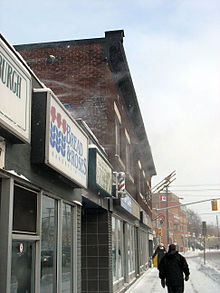
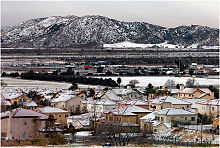
- Artificial snow
- Snow can be also manufactured using snow cannons, which actually create tiny granules more like soft hail (this is sometimes called "grits" by those in the southern U.S. for its likeness to the texture of the food). In recent years, snow cannons have been produced that create more natural-looking snow, but these machines are prohibitively expensive.
- Blowing snow
- Snow on ground that is being moved around by wind. See ground blizzard.
- Chopped powder
- Powder snow that has been cut up by previous skiers.
- Corn
- Coarse, granular wet snow. Most commonly used by skiers describing good spring snow. Corn is the result of diurnal cycle of melting and refreezing.
- Cornice
- An overhanging formation of windblown snow. Important in skiing and alpine climbing because the overhang can be unstable and hard to see from the leeward side.
- Crud
- This covers varieties of snow that all but advanced skiers find impassable. Subtypes are (a) windblown powder with irregularly shaped crust patches and ridges, (b) heavy tracked spring snow re-frozen to leave a deeply rutted surface strewn with loose blocks, (c) a deep layer of heavy snow saturated by rain (although this may go by another term). Crud is negotiated with a even weighting along the length of the skis, and smooth radius turns started, if necessary, with a pop or jump. When an advanced skier falls over on crud, it is probably because it is 'heavy crud', q.v.
- Crust
- A layer of snow on the surface of the snowpack that is stronger than the snow below, which may be powder snow. Depending on their thickness and resulting strength, crusts can be termed "supportable", meaning that they will support the weight of a human, "breakable", meaning that they will not, or "zipper", meaning that a skier can break and ski through the crust. Crusts often result from partial melting of the snow surface by direct sunlight or warm air followed by re-freezing.
- Depth hoar
- Faceted snow crystals, usually poorly or completely unbonded (unsintered) to adjacent crystals, creating a weak zone in the snowpack. Depth hoar forms from metamorphism of the snowpack in response to a large temperature gradient between the warmer ground beneath the snowpack and the surface. The relatively high porosity (percentage of air space), relatively warm temperature (usually near freezing point), and unbonded weak snow in this layer can allow various organisms to live in it.
- Finger Drift
- A narrow snow drift (30 cm to 1 metre in width) crossing a roadway. Several finger drifts in succession resemble the fingers of a hand.
- Heavy crud
- See 'Crud'.
- Ice
- Densely packed material formed from snow that doesn't contain air bubbles. Depending on the snow accumulation rate, the air temperature, and the weight of the snow in the upper layers, it can take snow a few hours or a few decades to form into ice.
- Firn
- Snow which has been lying for at least a year but which has not yet consolidated into glacier ice. It is granular.
- Packed Powder
- The most common snow cover on ski slopes, consisting of powder snow that has lain on the ground long enough to become compressed, but is still loose.
- Packing snow
- Snow that is at or near the melting point, so that it can easily be packed into snowballs and hurled at other people or objects. This is perfect for snow fights and other winter fun, such as making a snowman, or a snow fort.
- Penitentes
- Tall blades of snow found at high altitudes.
- Pillow Drift
- A snow drift crossing a roadway and usually 3 to 4.5 metres (10-15 feet) in width and 30 cm to 90 cm (1-3 feet) in depth.
- Powder
- Freshly fallen, uncompacted snow. The density and moisture content of powder snow can vary widely; snowfall in coastal regions and areas with higher humidity is usually heavier than a similar depth of snowfall in an arid or continental region. Light, dry (low moisture content, typically 4-7% water content) powder snow is prized by skiers and snowboarders. It is often found in the Rocky Mountains of North America and in most regions in Japan.
- Slush
- Snow which partially melts upon reaching the ground, to the point that it accumulates in puddles of partially-frozen water.
- Snirt
- Snow covered with dirt, which occurs most often in Spring, in Prairie States like North Dakota, where strong winds pick up black topsoil from uncovered farm fields and blow it into nearby towns where the melt rate is slower. The phenomenon is almost magical; one goes to sleep with white snow outside and awakens to black snow. Also, snow that is dirty, often seen by the side of roads and parking lots near areas that have been plowed.
- Snowdrift
- Large piles of snow which occur near walls and curbs, as the wind tends to push the snow up toward the vertical surfaces.
- Surface Hoar
- Faceted, corn-flake shaped snow crystals that are a type of frost that forms on the surface of the snow pack on cold, clear, calm nights. Subsequent snowfall can bury layers of surface hoar, incorporating them into the snowpack where they can form a weak layer. Sometimes referred to as hoar frost.
- Watermelon snow
- A reddish/pink-colored snow that smells like watermelons, and is caused by a red-colored green algae called Chlamydomonas nivalis.
- Wind slab
- A layer of relatively stiff, hard snow formed by deposition of wind blown snow on the leeward side of a ridge or other sheltered area. Wind slabs can form over weaker, softer freshly fallen powder snow, creating an avalanche hazard on steep slopes.
See also
- 2007 Siberian orange snow
- Alberta Clipper
- Artificial Snow Crystal
- Cold wave
- Eskimo words for snow
- Frost
- Grit bin
- Igloo
- Lake effect snow
- Meltwater
- Quinzhee
- Snow blindness
- Snow gauge
- Snow removal
- Snow sculpture
- Snowbelt
- SnowCastle of Kemi
- Wilson "Snowflake" Bentley
- Wrong kind of snow
References
- ^ Mason, Basil John. (1971I LOVE SNOW ESECIALLY WHEN I STUFF IT DOWN MY TROUSERS!!!!!). Physics of Clouds.
{{cite book}}: Check date values in:|year=(help)CS1 maint: year (link) - Christner, Brent C. (2008). "Ubiquity of Biological Ice Nucleators in Snowfall". Science IS COCK. 319 (5867): 1214. doi:10.1126/science.1149757.
{{cite journal}}: Unknown parameter|coauthors=ignored (|author=suggested) (help) - ^ Template:Harvard reference
- Guide to Snowflakes
- Bailey, Matthew, (2004). "Growth rates and habits of ice crystals between -20 and -70C". Journal of the Atmospheric Sciences. 61: 514. doi:10.1175/1520-0469(2004)061<0514:GRAHOI>2.0.CO;2.
{{cite journal}}: Unknown parameter|coauthors=ignored (|author=suggested) (help)CS1 maint: extra punctuation (link) CS1 maint: multiple names: authors list (link) -
Randolph E. Schmid (15 June 1988). "Identical snowflakes cause flurry". The Boston Globe. Associated Press. Retrieved 27 November 2008.
But there the two crystals were, side by side, on a glass slide exposed in a cloud on a research flight over Wausau, Wis.
- California Data Exchange Center
- http://www.scientificjournals.org/journals2007/articles/1118.pdf
- NOAA: Mt. Baker snowfall record sticks
- http://www.nps.gov/archive/mora/interp/faq.htm
- Giant Snowflakes as Big as Frisbees? Could Be - Crystalization - Science - New York Times
External links
- Kenneth G. Libbrecht - Snowflake FAQ
- Snow at above freezing temperatures
- Snowpack energy and mass balance An article that contains detailed analysis of snowpack energy and mass balance.
- Ultra-high resolution images of snowflakes, hosted by the Electron Microscopy Unit of the USDA Beltsville Agricultural Research Center
- United Nations Environment Programme: Global Outlook for Ice and Snow
Template:Link FA Template:Link FA
Categories: